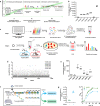A thermostable type I-B CRISPR-Cas system for orthogonal and multiplexed genetic engineering
- PMID: 37794017
- PMCID: PMC10551041
- DOI: 10.1038/s41467-023-41973-5
A thermostable type I-B CRISPR-Cas system for orthogonal and multiplexed genetic engineering
Abstract
Thermophilic cell factories have remarkably broad potential for industrial applications, but are limited by a lack of genetic manipulation tools and recalcitrance to transformation. Here, we identify a thermophilic type I-B CRISPR-Cas system from Parageobacillus thermoglucosidasius and find it displays highly efficient transcriptional repression or DNA cleavage activity that can be switched by adjusting crRNA length to less than or greater than 26 bp, respectively, without ablating Cas3 nuclease. We then develop an orthogonal tool for genome editing and transcriptional repression using this type I-B system in both thermophile and mesophile hosts. Empowered by this tool, we design a strategy to screen the genome-scale targets involved in transformation efficiency and established dynamically controlled supercompetent P. thermoglucosidasius cells with high efficiency ( ~ 108 CFU/μg DNA) by temporal multiplexed repression. We also demonstrate the construction of thermophilic riboflavin cell factory with hitherto highest titers in high temperature fermentation by genome-scale identification and combinatorial manipulation of multiple targets. This work enables diverse high-efficiency genetic manipulation in P. thermoglucosidasius and facilitates the engineering of thermophilic cell factories.
© 2023. Springer Nature Limited.
Conflict of interest statement
The authors have filed a provisional patent for this work to the China National Intellectual Property Administration (CNIPA: 202310705228X). W.W., Z.Y., Z.L., and R.B. are inventors on the provisional patent application. The remaining authors declare no competing interests.
Figures







Similar articles
-
A highly efficient method for genomic deletion across diverse lengths in thermophilic Parageobacillus thermoglucosidasius.Synth Syst Biotechnol. 2024 May 17;9(4):658-666. doi: 10.1016/j.synbio.2024.05.009. eCollection 2024 Dec. Synth Syst Biotechnol. 2024. PMID: 38817825 Free PMC article.
-
[Thermostable CRISPR/Cas9 genome editing system and its application in construction of cell factories with thermophilic bacteria: a review].Sheng Wu Gong Cheng Xue Bao. 2022 Apr 25;38(4):1475-1489. doi: 10.13345/j.cjb.210827. Sheng Wu Gong Cheng Xue Bao. 2022. PMID: 35470620 Review. Chinese.
-
Parageobacillus thermoglucosidasius Strain Engineering Using a Theophylline Responsive RiboCas for Controlled Gene Expression.ACS Synth Biol. 2024 Apr 19;13(4):1237-1245. doi: 10.1021/acssynbio.3c00735. Epub 2024 Mar 22. ACS Synth Biol. 2024. PMID: 38517011 Free PMC article.
-
CRISPR/Cas genome editing systems in thermophiles: Current status, associated challenges, and future perspectives.Adv Appl Microbiol. 2022;118:1-30. doi: 10.1016/bs.aambs.2022.02.001. Epub 2022 Feb 25. Adv Appl Microbiol. 2022. PMID: 35461662
-
Application of the CRISPR/Cas system for genome editing in microalgae.Appl Microbiol Biotechnol. 2019 Apr;103(8):3239-3248. doi: 10.1007/s00253-019-09726-x. Epub 2019 Mar 15. Appl Microbiol Biotechnol. 2019. PMID: 30877356 Review.
Cited by
-
Multiplex CRISPR-Cas Genome Editing: Next-Generation Microbial Strain Engineering.J Agric Food Chem. 2024 May 29;72(21):11871-11884. doi: 10.1021/acs.jafc.4c01650. Epub 2024 May 14. J Agric Food Chem. 2024. PMID: 38744727 Free PMC article. Review.
-
Repurposing endogenous type I-E CRISPR-Cas systems for natural product discovery in Streptomyces.Nat Commun. 2024 Nov 13;15(1):9833. doi: 10.1038/s41467-024-54196-z. Nat Commun. 2024. PMID: 39537651 Free PMC article.
-
Hi-TARGET: a fast, efficient and versatile CRISPR type I-B genome editing tool for the thermophilic acetogen Thermoanaerobacter kivui.Biotechnol Biofuels Bioprod. 2025 Apr 30;18(1):49. doi: 10.1186/s13068-025-02647-0. Biotechnol Biofuels Bioprod. 2025. PMID: 40307869 Free PMC article.
-
The engineering toolbox of Parageobacillus thermoglucosidasius.Appl Microbiol Biotechnol. 2025 Jul 9;109(1):163. doi: 10.1007/s00253-025-13508-z. Appl Microbiol Biotechnol. 2025. PMID: 40632236 Free PMC article. Review.
-
Biofuel production from lignocellulose via thermophile-based consolidated bioprocessing.Eng Microbiol. 2024 Sep 10;4(4):100174. doi: 10.1016/j.engmic.2024.100174. eCollection 2024 Dec. Eng Microbiol. 2024. PMID: 39628591 Free PMC article. Review.
References
-
- Ro DK, et al. Production of the antimalarial drug precursor artemisinic acid in engineered yeast. Nature. 2006;440:940–943. - PubMed
-
- Wang W, et al. Harnessing the intracellular triacylglycerols for titer improvement of polyketides in Streptomyces. Nat. Biotechnol. 2020;38:76–83. - PubMed
-
- Chen GQ, Jiang XR. Next generation industrial biotechnology based on extremophilic bacteria. Curr. Opin. Biotechnol. 2018;50:94–100. - PubMed
Publication types
MeSH terms
Substances
LinkOut - more resources
Full Text Sources
Molecular Biology Databases

